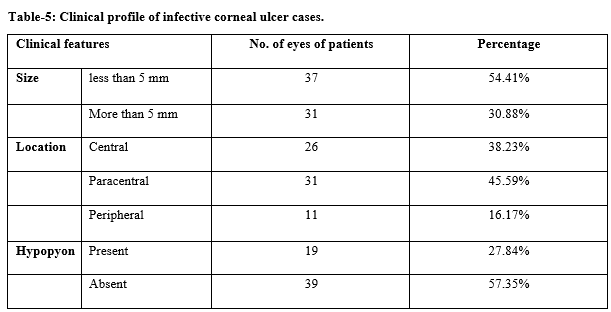Study of clinical and microbiological profile of infective corneal ulcers at a tertiary care hospital in western Maharashtra
Abstract
Introduction: Infective corneal ulcer is an important cause of visual impairment in developing countries. The present study was conducted to know demographic, clinical, and microbiological patterns of infective corneal ulcers in a tertiary hospital in western Maharashtra.
Materials and Methods: This is a retrospective analytical study involving 68 eyes of 68 cases of infective corneal ulcer visited in the last two years. From medical records of all cases, details of history, clinical findings, and investigations were noted and data were analyzed.
Results: Male to female ratio of study cases was 1.61:1 with age groups ranging between 18 to 90 years (mean 50.81 years). The main occupations of study cases were farming (28 i.e. 41.17%) and construction work (12 i.e.17.64%). Thirty-two (47.05%) cases had to present BCVA of <6/60. Corneal ulcers of size < 5 mm were seen in 37 (54.41%) cases and 19 cases (27.84%) had hypopyon. Central and paracentral ulcers were seen in 57 cases (83.82%). On Gram stain and 10% KOH mount, fungal etiology (26.92%) was seen more frequently than bacterial etiology (20.51%) and 4(5.88%) showed mixed organisms. In 37(54.41%) cases where no organisms were detected, 6 cases had clinical features of viral corneal ulcer.
Conclusion: Infective corneal ulcers mainly affected working males involved in farming. Gram stain and KOH mount analysis showed fungal etiology more frequently than bacterial. Detailed history, clinical examination, and lab investigations of scrapings in cases of infective corneal ulcers are essential to know the clinical and microbiological pattern.
Downloads
References
Assudani HJ, Pandya JM, Sarvan R, Sapre AM, Gupta AR, Mehta SJ. Etiological diagnosis of microbial keratitis in a tertiary care hospital in Gujarat. Natl J Med Res. 2013;3(1):60-62.
Insan NG, Mane V, Chaudhary BL, Danu MS, Yadav A, Srivastava V. A review of fungal keratitis: Etiology and laboratory diagnosis. Int J Curr Microbiol App Sci. 2013;2(6):307–314.
Mehta S, Mehta M. Clinical and Microbiological Profile and Treatment Outcome of Infective Corneal Ulcers: A Study in Central India. Int J Sci Stud. 2017;4(12):234-240. doi: https://doi.org/10.17354/ijss/2017/134.
Katara RS, Patel ND, Sinha M. A Clinical Microbiological Study of Corneal Ulcer Patients at Western Gujarat, India. Acta Med Iran. 2013;51(6):399-403.
Sihota R, Tandon R. Parsons. Diseases of eye. 22nd edition. Elsevier publications, 2015,pg 198-203.
Gonzales CA, Srinivasan M, Whitcher JP, Smolin G. Incidence of corneal ulceration in Madurai district, South India. Ophthalmic Epidemiol. 1996;3(3):159-166. doi: https://doi.org/10.3109/09286589609080122.
Ranjini CY, Waddepally VV. Microbial Profile of Corneal Ulcers in a Tertiary Care Hospital in South India. J Ophthalmic Vis Res. 2016;11(4):363‐367. doi: https://doi.org/10.4103/2008-322X.194071
Gopinathan U, Sharma S, Garg P, Rao GN. Review of epidemiological features, microbiological diagnosis and treatment outcome of microbial keratitis: Experience of over a decade. Indian J Ophthalmol. 2009;57(4):273–279. doi: https://dx.doi.org/10.4103%2F0301-4738.53051.
Kenia VP, Kenia RV, Pirdankar OH. Diagnosis and management protocol of acute corneal ulcer. Int J Health Sci Res. 2020; 10(3):69-78.
Mohod PN, Nikose AS, Laddha PM, Bharti S. Incidence of various causes of infectious keratitis in the part of rural central India and its visual morbidity: Prospective hospital-based observational study. J Clin Ophthalmol Res. 2019;7(1):31-34. Available from: http://www.jcor.in/text.asp?2019/7/1/31/253988.
Srinivasan M, Gonzales CA, George C, Cevallos V, Mascarenhas JM, Asokan B, et al. Epidemiology and aetiological diagnosis of corneal ulceration in Madurai, South India. Br J Ophthalmol. 1997;81(11):965-971. doi: https://doi.org/10.1136/bjo.81.11.965.
Panda A, Satpathy G, Nayak N, Kumar S, Kumar A. Demographic pattern, predisposing factors and
management of ulcerative keratitis: Evaluation of one thousand unilateral cases at a tertiary care centre. Clin Exp Ophthalmol. 2007;35(1):44‑50. doi: https://doi.org/10.1111/j.1442-9071.2007.01417.x.
Khare P, Shrivastava M, Kumar K. Study of epidemiological characters, predisposing factors and treatment outcome of corneal ulcer patients. Int J Med Res Rev . 2014;2(1):33-39. Available from: https://ijmrr.medresearch.in/index.php/ijmrr/article/view/55.
Puri L, Shrestha G. Microbial keratitis: A five years retrospective clinical study in tertiary eye hospital of eastern region of Nepal. JKMC.2017;4(4):118-125. Available from: https://www.nepjol.info/index.php/JKMC/article/view/18252.
Waghmare AS, Sadanand PK. Clinical and microbiological profile of infective keratitis and their antibiotic sensitivity. Indian J Microbiol Res. 2019;6(1):11-14.
Amrutha KB, Venkatesha D. Microbiological profile of Ulcerative Keratitis in a tertiary care hospital. Int J Res Health Sci. 2014;2(2):599-603. Available from http://www.ijrhs.com/issues.php?val=Volume2&iss=Issue2.
Shah A, Sachdev A, Coggon D, Hossain P. Geographic variations in microbial keratitis: an analysis of the peer-reviewed literature. Br J Ophthalmol. 2011;95(6):762‐767. doi: https://dx.doi.org/10.1136%2Fbjo.2009.169607.
Khadka S, Chaudhary M, Thapa M. Evaluation of risk factors and treatment outcome of microbial keratitis in a tertiary eye center. Sudanese J Ophthalmol 2018;10(1):25-31. Available from: http://www.sjopthal.net/text.asp?2018/10/1/25/240546.

Copyright (c) 2020 Author (s). Published by Siddharth Health Research and Social Welfare Society

This work is licensed under a Creative Commons Attribution 4.0 International License.


 OAI - Open Archives Initiative
OAI - Open Archives Initiative



















 Therapoid
Therapoid

